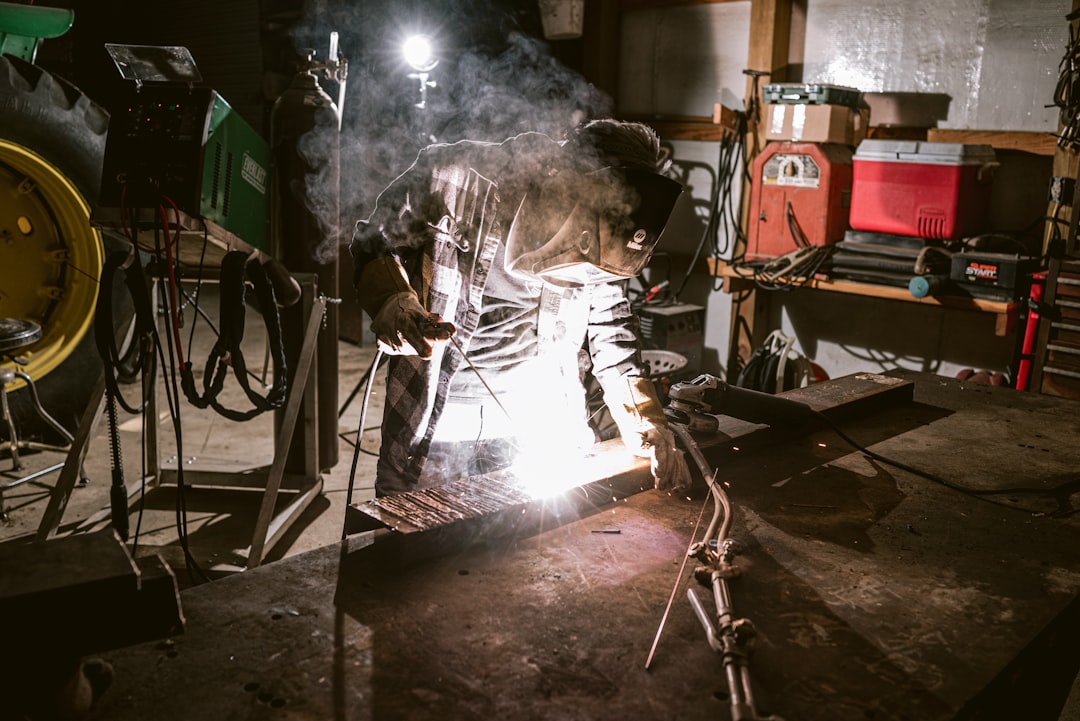

Engage prospects with a scan and streamline customer engagement with FREE QR code marketing tools by Sona – no strings attached!
Create a Free QR CodeFree consultation

No commitment

Engage prospects with a scan and streamline customer engagement with FREE QR code marketing tools by Sona – no strings attached!
Create a Free QR CodeFree consultation

No commitment
Welding schools are facing a pivotal challenge: gathering timely, actionable feedback from students has long been hindered by outdated analog methods. Traditional paper surveys and feedback forms are labor-intensive, prone to low response rates, and rarely provide the insight needed for continuous improvement and agile decision-making. In a highly competitive education market where student voice and program quality drive enrollments, missing opportunities to capture input from students who choose not to speak up or complete feedback forms can translate into overlooked program improvements and lost prospective applicants.
Today's students expect instant, seamless interactions, and emerging digital touchpoints are now an expectation, not an exception. Yet, many welding programs still miss high-value insights simply because engagement is not tracked or anonymous visitors remain invisible. QR codes provide an easy and effective way for welding schools to bridge the gap between structured classroom environments and digital engagement, enabling students to share feedback with just a scan, even during brief interactions or between classes. For ideas tailored to education environments, see QR codes in education.
By introducing dynamic, trackable QR code solutions into feedback workflows, welding schools can achieve higher response rates, richer data, and a streamlined experience for both educators and students. Administrators now benefit from immediate visibility into evolving student needs, mitigating the risk of relying on incomplete or outdated feedback. The following guide explains how QR codes can unlock new levels of efficiency, insight, and growth within welding education programs.

QR codes empower welding schools to turn traditional, slow-touch feedback processes into instant, actionable digital journeys. A frequent pain point is missing high-value student or prospect data when feedback relies on forms that are easily overlooked or not submitted; modern QR-driven feedback makes each interaction instantly trackable and actionable, as seen in this LightBurn forum thread on automating QR workflows. By placing QR codes on classroom doors, lab workstations, student lockers, and training materials, schools reduce the friction that causes feedback to be lost or delayed, improving both response rates and data quality.
Another persistent issue is timing. Students often receive end-of-course email surveys when their attention has shifted to exams, work schedules, or new classes. QR codes deliver the prompt at the right moment: on the bench after a lab, on a handout after a demonstration, or at the exit door after a practical exam. With visible placement, clear calls to action, and mobile-friendly destinations, more students participate and they do so while the experience is fresh.
Platforms such as Sona QR streamline code generation, tracking, and integrations. For example, replacing printed end-of-course surveys with QR-driven forms gives instructors instant access to aggregate results by cohort or section. This closes the feedback loop quickly and makes it easy to adapt teaching techniques, modify lab pacing, and prioritize equipment maintenance based on real student input. Explore features on Sona QR.

For welding schools, QR codes solve a critical challenge: eliminating friction in the feedback process. Many prospective and current students weigh program improvements, instructor quality, and job placement support when evaluating offerings, yet a lack of visibility into who is engaging often means that silent signals of satisfaction, confusion, or interest are never captured. When anonymous feedback sources go undeclared, or when students researching programs never register their opinions, schools miss out on opportunities for course correction and growth.
QR codes also bring accountability to analog touchpoints. Posters, lab signage, and event handouts usually cannot reveal which messages or moments drive action. With QR codes, every scan becomes a traceable event that shows how students move from interest to feedback to resolution. This turns static assets into dynamic tools that can be measured, optimized, and scaled. For in-facility placements, consider digital signage.
Schools can also leverage QR-triggered flows beyond feedback. Examples include equipment check-out logs, maintenance requests, safety training validations, and job placement follow-ups. Each scan feeds timely, structured data back to the school, which reduces compliance risks and improves student support.

Welding schools benefit most from QR code formats that directly align with student workflows and administrative needs. The right format ensures the scan launches the exact action you want, whether that is a course evaluation or a maintenance request.
Dynamic codes are particularly valuable in education environments since course structures and resources change frequently. With a platform like Sona QR, staff can generate all of these formats, swap destinations on the fly, and manage them in one central dashboard.

Deploy QR codes at student touchpoints where offline-to-online engagement is most vulnerable to being missed or inadequately tracked. The aim is to capture signals at the moment of interest so that insights and follow-ups do not slip away. For more ideas, browse Sona QR’s use case library.
Strategic placement also aligns feedback with specific contexts. A QR code on a welding booth invites comments about equipment or safety, while a code on a classroom door captures input about lecture pace or clarity. This contextual relevance improves both participation quality and the actionability of the data you receive.
By targeting these moments, welding schools can generate a continuous flow of actionable insights across the student lifecycle. You will reduce missed opportunities from busy classrooms, short breaks, and end-of-term rushes.

QR codes are most effective when grounded in repeatable, high-impact scenarios. The following use cases tie directly to common interactions in welding programs and produce measurable outcomes.
Each of these deployments ties scanning to immediate value: students know their input matters, staff receives structured data, and leaders get visibility across programs. Over time, schools can benchmark performance, reward effective practices, and allocate resources to areas of greatest impact.
Each QR scan is a meaningful signal of interest, intent, or need. By deploying distinct QR codes across admissions, instruction, safety, and alumni engagement, schools can segment audiences automatically and deliver targeted follow-ups that convert interest into action. For strategy, see Sona’s blog post Essential Guide to Intent Data.
In practice, this means separating prospects from current students, differentiating first-term cohorts from advanced welders, and tracking which alumni remain active. These distinctions inform the content and cadence of your outreach and help avoid one-size-fits-all messaging that gets ignored.
With Sona QR, each code becomes a smart entry point that attaches intent data to a profile. This lets you prioritize high-fit leads, personalize instruction support, and encourage alumni advocacy based on demonstrated interest rather than assumptions.
QR codes help welding schools connect print assets, in-person events, and digital campaigns into a cohesive funnel. Each code transforms a physical surface into a measurable call to action, while centralized tracking reveals which channels truly drive engagement, applications, or satisfaction.
Balanced integration also improves student experience. Learners see consistent prompts and destinations across brochures, classrooms, websites, and social media. That consistency reduces confusion and increases trust that scanning will be worth their time.
With a platform like Sona QR, schools can monitor performance across all of these channels and sync scan data into downstream systems. This turns multi-channel marketing into a reinforced experience that guides learners from awareness to enrollment, and from coursework to completion.
Launching a QR initiative in a welding school is straightforward when you approach it with clear goals and disciplined measurement. The following steps help you move from concept to continuous improvement without losing momentum or data fidelity.
Use this checklist for any campaign: a new course launch, a safety reporting initiative, or an alumni outreach push. Keep your audience and environment in mind and tailor the design, CTA, and placement accordingly.
Welding schools must prove the ROI of both feedback initiatives and marketing spend. Without robust tracking, valuable signals get lost and teams cannot attribute outcomes to specific campaigns or placements. QR codes transform anonymous interactions into measurable events that reveal which messages and moments work.
Sona QR and Sona.com extend this capability from scan to outcome. Sona is an AI-powered marketing platform that turns first-party data into revenue through automated attribution, data activation, and workflow orchestration. You not only capture when and where a scan occurred, but you also connect that action to subsequent form fills, advising bookings, and enrollment decisions. For measurement frameworks, read Sona’s blog post Essential Guide to Offline Attribution.
The result is a shift from anecdotal opinions to evidence-based decisions. By tracing a line from scan to submission to enrollment, administrators can defend budgets, optimize campaigns, and continuously elevate the student experience.
A few practical habits can dramatically increase scan rates and the quality of data you collect. Start with clarity and consistency, then enhance your reach with automation and targeted placements.
Sustained success also depends on education. Students and staff should understand why scanning matters, what happens next, and how their input drives change. When people see action from their feedback, they participate more and share better ideas.
QR codes have quickly become a vital component for welding schools seeking to move beyond the limitations of analog feedback and piecemeal engagement tracking. By embedding codes at each critical touchpoint, educators can surface hidden prospects, capture student interest before it dissipates, and build an accurate picture of satisfaction and learning outcomes. Every scan is both a signal and an opportunity to listen, learn, and make targeted improvements.
When paired with a platform like Sona QR and the attribution capabilities of Sona.com, QR-enabled workflows extend from scan to insight to action. Schools gain the ability to segment audiences, automate follow-ups, and attribute outcomes to specific campaigns. The result is a data-driven environment where teams respond to changing needs with speed and precision, setting a new standard for operational efficiency and student-centered progress across welding education. Start creating QR codes for free at Sona QR.
QR codes have revolutionized welding schools by transforming traditional feedback collection into an efficient, real-time engagement tool. Whether it’s gathering detailed student insights, enhancing learning experiences, or streamlining instructor evaluations, QR codes replace cumbersome paper surveys with instant, mobile-friendly actions that capture valuable data to improve training outcomes.
Imagine having immediate access to student feedback after every welding session, enabling you to adapt curriculum and teaching methods on the fly. With Sona QR, you can create dynamic, trackable QR codes in seconds, update feedback forms without reprinting, and connect every scan directly to actionable insights—ensuring no valuable opinion goes unheard. Start for free with Sona QR today and turn every scan into a step toward a stronger, more responsive welding education program.
Traditional feedback methods like paper surveys are labor-intensive, have low response rates, and rarely provide timely, actionable insights for program improvement.
QR codes enable instant, trackable, and context-specific digital feedback that increases response rates, captures richer data, and reduces the friction of manual surveys.
Effective placements include classroom doors, lab workstations, student lockers, training materials, event registration desks, and printed handouts.
Common formats include web links for surveys, vCards for contact info, SMS or email triggers for requests, Wi-Fi access codes, and app download links.
Dynamic QR codes allow link destinations to be updated without reprinting, enable scan tracking for analytics, and support integrations with CRM or student information systems.
QR codes can be used for equipment check-out logs, maintenance requests, safety training validations, job placement follow-ups, and event lead capture.
By deploying distinct QR codes by program stage, skill level, location, and timing, schools can automatically segment prospects, current students, and alumni for personalized follow-ups.
Key steps include defining campaign goals, selecting QR code types, designing and testing codes, deploying them strategically, and tracking plus optimizing performance.
QR codes provide detailed scan analytics such as time, location, and device data, which can be integrated with CRM systems to attribute engagement to applications and enrollments.
Tips include using unique codes per course, adding tracking parameters, training instructors to promote scanning, automating follow-ups, and creatively placing codes in relevant locations.
Use Sona QR's trackable codes to improve customer acquisition and engagement today.
Create Your FREE Trackable QR Code in SecondsJoin results-focused teams combining Sona Platform automation with advanced Google Ads strategies to scale lead generation

Connect your existing CRM

Free Account Enrichment

No setup fees
No commitment required

Free consultation

Get a custom Google Ads roadmap for your business






Launch campaigns that generate qualified leads in 30 days or less.
